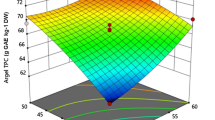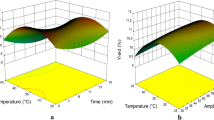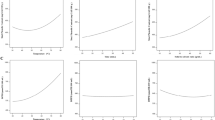Abstract
This study aimed to optimise ultrasound-assisted extraction (UAE) conditions of the brown alga Hormosira banksii for total phenolic content (TPC) and antioxidant activities including total antioxidant capacity (ABTS), DPPH free radical scavenging capacity (DPPH) and ferric reducing antioxidant power (FRAP) using response surface methodology (RSM). Box–Behnken design was employed to assess the effect of ultrasonic temperature, time and power on the TPC and antioxidant activities of the extracts. The results showed that RSM was an accurate and reliable method in predicting TPC and antioxidant activities (ABTS, DPPH and FRAP) of the extracts with R 2 values of 0.97, 0.96, 0.92 and 0.94, respectively. The ultrasonic temperature and time had the significant impact on TPC and antioxidant capacities. The optimal UAE conditions for the maximal values of TPC and antioxidant activities were of 30 °C, 60 min and power 60%, or 150 W. The values of TPC and antioxidant activities (ABTS, DPPH, FRAP) achieved under these parameters were 23.12 (mg GAE g−1), 85.64 (mg TE g−1), 47.24 (mg TE g−1) and 12.56 (mg TE g−1), respectively. UAE was found to be more efficient in comparison to conventional extraction, with shorter time for extraction and higher of TPC level and antioxidant activities. Therefore, ultrasonic-assisted extraction using RSM is effective for extraction and further isolation and purification of phenolic compounds from H. banksii. In addition, this alga could be a potential rich source of natural antioxidants applied in food and pharmaceutical fields.





Similar content being viewed by others
References
Alghazwi M, Kan YQ, Zhang W, Gai WP, Garson MJ, Smid S (2016) Neuroprotective activities of natural products from marine macroalgae during 1999–2015. J Appl Phycol 28:3599–3616
Azmir J, Zaidul I, Rahman M, Sharif K, Mohamed A, Sahena F, Omar A (2013) Techniques for extraction of bioactive compounds from plant materials: a review. J Food Eng 117:426–436
Benzie I, Strain J (1999) Ferric reducing/antioxidant power assay: direct measure of total antioxidant activity of biological fluids and modified version for simultaneous measurement of total antioxidant power and ascorbic acid concentration. Meth Enzymol 299:15–27
Brand-Williams W, Cuvelier M, Berset C (1995) Use of a free radical method to evaluate antioxidant activity. LWT-Food Sci Technol 28:25–30
Cabrita MT, Vale C, Rauter AP (2010) Halogenated compounds from marine algae. Mar Drugs 8:2301–2317
Charoensiddhi S, Franco C, Su P, Zhang W (2015) Improved antioxidant activities of brown seaweed Ecklonia radiata extracts prepared by microwave-assisted enzymatic extraction. J Appl Phycol 27:2049–2058
Chemat F, Khan MK (2011) Applications of ultrasound in food technology: processing, preservation and extraction. Ultrason Sonochem 18:813–835
Dang TT, Vuong QV, Schreider MJ, Bowyer MC, Altena IAV, Scarlett CJ (2016) The effects of drying on physico-chemical properties and antioxidant capacity of the brown alga (Hormosira banksii (Turner) Decaisne). J Food Process Preserv. doi:10.1111/jfpp.13025
De Souza ÉT, Pereira de Lira D, Cavalcanti de Queiroz A, Costa da Silva DJ, Bezerra de Aquino A, Campessato Mella EA, de Oliveira Chaves MC (2009) The antinociceptive and anti-inflammatory activities of caulerpin, a bisindole alkaloid isolated from seaweeds of the genus Caulerpa. Mar Drugs 7:689–704
Dey S, Rathod VK (2013) Ultrasound assisted extraction of β-carotene from Spirulina platensis. Ultrason Sonochem 20:271–276
El Gamal AA (2010) Biological importance of marine algae. Saudi Pharmaceutical Journal 18:1–25
Ferreres F, Lopes G, Gil-Izquierdo A, Andrade PB, Sousa C, Mouga T, Valentão P (2012) Phlorotannin extracts from Fucales characterized by HPLC-DAD-ESI-MSn: approaches to hyaluronidase inhibitory capacity and antioxidant properties. Mar Drugs 10:2766–2781
Filgueiras A, Capelo J, Lavilla I, Bendicho C (2000) Comparison of ultrasound-assisted extraction and microwave-assisted digestion for determination of magnesium, manganese and zinc in plant samples by flame atomic absorption spectrometry. Talanta 53:433–441
Frankel EN, Meyer AS (2000) The problems of using one-dimensional methods to evaluate multifunctional food and biological antioxidants. J Sci Food Agric 80:1925–1941
Gupta S, Abu-Ghannam N (2011) Bioactive potential and possible health effects of edible brown seaweeds. Trends Food Sci Technol 22:315–326
Han D, Zhu T, Row KH (2011) Ultrasonic extraction of phenolic compounds from Laminaria japonica Aresch using ionic liquid as extraction solvent. Bull Kor Chem Soc 32:2212–2216
Hossain MB, Brunton NP, Patras A, Tiwari B, O’Donnell C, Martin-Diana AB, Barry-Ryan C (2012) Optimization of ultrasound assisted extraction of antioxidant compounds from marjoram ( Origanum majorana L.) using response surface methodology. Ultrason Sonochem 19:582–590
Jiménez-Escrig A, Jiménez-Jiménez I, Pulido R, Saura-Calixto F (2001) Antioxidant activity of fresh and processed edible seaweeds. J Sci Food Agric 81:530–534
Júnior SQ, Carneiro VHA, Fontenelle TPC, de Sousa CL, Mesquita JX, de Brito TV, Aragão KS (2015) Antioxidant and anti-inflammatory activities of methanol extract and its fractions from the brown seaweed Spatoglossum schroederi. J Appl Phycol 27:2367–2376
Kadam SU, Tiwari BK, O’Connell S, O’Donnell CP (2015) Effect of ultrasound pretreatment on the extraction kinetics of bioactives from brown seaweed (Ascophyllum nodosum). Separation Sci Technol 50:670–675
Kadam SU, Tiwari BK, O’Donnell CP (2013) Application of novel extraction technologies for bioactives from marine algae. J Agric Food Chem 61:4667–4675
Kha TC, Nguyen MH, Phan DT, Roach PD, Stathopoulos CE (2013) Optimisation of microwave-assisted extraction of Gac oil at different hydraulic pressure, microwave and steaming conditions. Int J Food Sci Technol 48:1436–1444
Kumar SR, Hosokawa M, Miyashita K (2013) Fucoxanthin: a marine carotenoid exerting anti-cancer effects by affecting multiple mechanisms. Mar Drugs 11:5130–5147
Kwak JY (2014) Fucoidan as a marine anticancer agent in preclinical development. Mar Drugs 12:851–870
Le Lann K, Jegou C, Stiger-Pouvreau V (2008) Effect of different conditioning treatments on total phenolic content and antioxidant activities in two Sargassacean species: comparison of the frondose Sargassum muticum (Yendo) Fensholt and the cylindrical Bifurcaria bifurcata R. Ross. Phycol Res 56:238–245
Macías-Sánchez M, Mantell C, Rodriguez M, de la Martínez de la Ossa E, Lubián L, Montero O (2009) Comparison of supercritical fluid and ultrasound-assisted extraction of carotenoids and chlorophyll a from Dunaliella salina. Talanta 77:948–952
Martins CDL, Ramlov F, Carneiro NPN, Gestinari LM, dos Santos BF, Bento LM, Horta PA (2013) Antioxidant properties and total phenolic contents of some tropical seaweeds of the Brazilian coast. J Appl Phycol 25:1179–1187
Matanjun P, Mohamed S, Mustapha NM, Muhammad K, Ming CH (2008) Antioxidant activities and phenolics content of eight species of seaweeds from north Borneo. J Appl Phycol 20:367–373
Millar A, Kraft G (1994) Catalogue of marine brown algae (Phaeophyta) of New South Wales, including Lord Howe Island, south-western Pacific. Aust Systemat Bot 7:1–47
Miyake Y, Sasaki S, Ohya Y, Miyamoto S, Matsunaga I, Yoshida T, Oda H (2006) Dietary intake of seaweed and minerals and prevalence of allergic rhinitis in Japanese pregnant females: baseline data from the Osaka Maternal and Child Health Study. Ann Epidemiol 16:614–621
Mohamed S, Hashim SN, Rahman HA (2012) Seaweeds: a sustainable functional food for complementary and alternative therapy. Trends Food Sci Technol 23:83–96
Okada Y, Ishimaru A, Suzuki R, Okuyama T (2004) A new phloroglucinol derivative from the brown alga Eisenia bicyclis: potential for the effective treatment of diabetic complications. J Nat Prod 67:103–105
Onofrejová L, Vašíčková J, Klejdus B, Stratil P, Mišurcová L, Kráčmar S, Vacek J (2010) Bioactive phenols in algae: the application of pressurized-liquid and solid-phase extraction techniques. J Pharmaceut Biomed Anal 51:464–470
Polshettiwar V, Varma RS (2008) Aqueous microwave chemistry: a clean and green synthetic tool for rapid drug discovery. Chem Soc Rev 37:1546–1557
Pompeu D, Silva E, Rogez H (2009) Optimisation of the solvent extraction of phenolic antioxidants from fruits of Euterpe oleracea using response surface methodology. Bioresour Technol 100:6076–6082
Romanik G, Gilgenast E, Przyjazny A, Kamiński M (2007) Techniques of preparing plant material for chromatographic separation and analysis. J Biochem Biophys Meth 70:253–261
Roselló-Soto E, Galanakis CM, Brnčić M, Orlien V, Trujillo FJ, Mawson R, Barba FJ (2015) Clean recovery of antioxidant compounds from plant foods, by-products and algae assisted by ultrasounds processing. Modeling approaches to optimize processing conditions. Trends Food Scie Technol 42:134–149
Shahidi F, Janitha P, Wanasundara P (1992) Phenolic antioxidants. Crit Rev Food Sci Nutr 32:67–103
Shi D, Li X, Li J, Guo S, Su H, Fan X (2010) Antithrombotic effects of bromophenol, an alga-derived thrombin inhibitor. Chin J Oceanol Limnol 28:96–98
Tanniou A, Leon ES, Laurent V, Elena I, Mendiola JA, Stéphane C, Valérie SP (2013) Green improved processes to extract bioactive phenolic compounds from brown macroalgae using Sargassum muticum as model. Talanta 104:44–52
Teh SS, Birch EJ (2014) Effect of ultrasonic treatment on the polyphenol content and antioxidant capacity of extract from defatted hemp, flax and canola seed cakes. Ultrason Sonochem 21:346–353
Thaipong K, Boonprakob U, Crosby K, Cisneros-Zevallos L, Hawkins Byrne D (2006) Comparison of ABTS, DPPH, FRAP, and ORAC assays for estimating antioxidant activity from guava fruit extracts. J Food Compos Anal 19:669–675
Topuz OK, Gokoglu N, Yerlikaya P, Ucak I, Gumus B (2016) Optimisation of antioxidant activity and phenolic compound extraction conditions from red seaweed (Laurencia obtusa). J Aquat Food Prod Technol 25:424–422
Vuong QV, Goldsmith CD, Dang TT, Nguyen VT, Bhuyan DJ, Sadeqzadeh E, Bowyer MC (2014) Optimisation of ultrasound-assisted extraction conditions for phenolic content and antioxidant capacity from Euphorbia tirucalli using response surface methodology. Antioxidants 3:604–617
Vuong QV, Hirun S, Roach PD, Bowyer MC, Phillips PA, Scarlett CJ (2013) Effect of extraction conditions on total phenolic compounds and antioxidant activities of Carica papaya leaf aqueous extracts. J Herbal Med 3:104–111
Wang J, Sun B, Cao Y, Tian Y, Li X (2008) Optimisation of ultrasound-assisted extraction of phenolic compounds from wheat bran. Food Chem 106:804–810
Wijesinghe W, Jeon YJ (2012) Enzyme-assistant extraction (EAE) of bioactive components: a useful approach for recovery of industrially important metabolites from seaweeds: a review. Fitoterapia 83:6–12
Wu Y, Wang X, Fan E (2012) Optimisation of ultrasound-assisted extraction of puerarin and total isoflavones from Puerariae Lobatae Radix (Pueraria lobata (Wild.) Ohwi) with response surface methodology. Phytochem Anal 23:513–519
Zhao S, Kwok KC, Liang H (2007) Investigation on ultrasound assisted extraction of saikosaponins from Radix bupleuri. Sep Purif Technol 55:307–312
Acknowledgements
The authors would like acknowledge the following funding support: Ramaciotti Foundation (ES2012/0104). The authors also kindly thank the University of Newcastle, Faculty of Science and IT, the Vietnamese Government through the Vietnam International Education Development - Ministry of Education and Training and the Ministry of Agriculture and Rural Development and the University of Newcastle for awarding a VIED-TUIT scholarship to Thanh Trung DANG.
Author information
Authors and Affiliations
Corresponding author
Rights and permissions
About this article
Cite this article
Dang, T.T., Van Vuong, Q., Schreider, M.J. et al. Optimisation of ultrasound-assisted extraction conditions for phenolic content and antioxidant activities of the alga Hormosira banksii using response surface methodology. J Appl Phycol 29, 3161–3173 (2017). https://doi.org/10.1007/s10811-017-1162-y
Received:
Revised:
Accepted:
Published:
Issue Date:
DOI: https://doi.org/10.1007/s10811-017-1162-y




